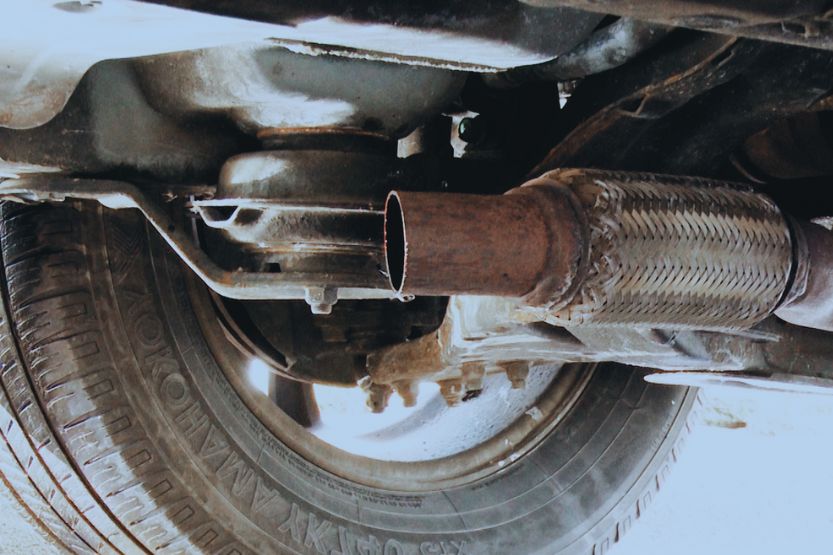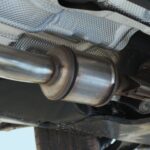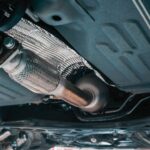Are you worried about the rising number of cases of thefts involving cars’ catalytic converters in your area? Are there measures that you can take to prevent it from happening to your car? This article will serve as your complete guide to catalytic converter theft prevention.
There are many methods you can use for catalytic converter theft prevention. The most common preventive measures include, but are not limited to, the following:
- Make Your Car a Difficult Target
- Don’t Park in One Spot Often
- Know if Your Car is a Popular Target
- Install an Alarm/Safety Camera System
- Paint Your Catalytic Converter Bright Colors
- Etch Your VIN on Your Catalytic Converter
- Put Up a Security Fence
- Install A Catalytic Converter Anti-Theft Cage
- Make Sure Your Converter is Covered by Your Insurance
- Get an Electric Vehicle
Learn about catalytic converter theft prevention to keep your car safe.
Catalytic Converter Theft Prevention

So how can you prevent your catalytic converter from being subjected to theft? Here are a few tips:
1. Make Your Car a Difficult Target
One way to prevent the theft of your catalytic converter is not to make it an obvious target for thieves. Thieves usually have their eyes on the cars hidden from the general public’s view. They are usually parked at the ends of the parking lot.
Ensure your car is always visible from the entrance of the establishment you are entering. This makes it a riskier target for thieves as people are likely to witness what is happening.
2. Don’t Park in One Spot Often
In most cases, the thieves would first check out the cars they will be stealing from. That said, you should not park in the same spot every day. Also, if you usually park in the street when you are at home, stop it. If you have a garage, put your car in it and keep the door closed.
3. Know if Your Car is a Popular Target
Call your local muffler shop. They are the ones who most likely know what kinds of cars are the usual targets of catalytic converter thieves.
Knowing if your car is a hot target will make you more cautious and mindful of your parking spot.
According to statistics, the number 1 target of catalytic converter thieves is the Toyota Prius. Because it is an ultra-low emission vehicle, the Prius’ catalytic converter contains more precious metals than usual. This is why Toyota Prius catalytic converter theft prevention devices are popular.
In addition, trucks and SUVs like the Ford F150 and the Honda CRV are also popular targets. The reason is that thieves do not need to jack up the vehicles to get under them. Most anti-theft devices have structures made explicitly for certain models.
This means Honda CRV catalytic converter theft prevention devices have different sizes than F150 catalytic converter theft prevention products.
4. Install an Alarm/Camera System
If allowed, you can turn up the sensitivity of your car’s alarm system. This way, even a slight jolt in the car will trigger the alarm. However, this does come with a caveat. If a raccoon bumps your car in the middle of the night, your neighbors will love you in the morning.
Some alarm systems trigger when the vehicle tilts on its side, like when it gets jacked up. You can also install a dashcam system that turns on automatically when it detects motion near the car.
This might not be able to prevent the theft of your catalytic converter. However, you will have a video you can give the authorities. It might help bring criminals to justice.
5. Paint Your Catalytic Converter Bright Colors
Another way to deter criminals from stealing your car’s catalytic converter is to paint it bright colors. Some examples are fluorescent oranges or greens. However, because the catalytic converter tends to heat quite a lot, use high-temperature paints.
This makes it somewhat easier to trace when it does get stolen. This will also make it harder for the thieves to sell your catalytic converter. Most legitimate junk shops will not buy stolen items.
6. Etch Your VIN on the Catalytic Converter
You can also take the prevention a step further by etching the VIN or the license plate of the vehicle. Etch it into the catalytic converter. If it gets stolen and the police managed to get it, they will locate you more easily.
In addition, you can also deter thieves from continuing their illegal activity. This is especially true if they discovered your etched identification marks on the catalytic converter. The law forbids many scrapyards from buying any part of a car with identifying marks.
7. Put Up a Security Fence
Thieves will not be interested in your catalytic converter if they cannot see your car. The same is true if they find a fence surrounding it. Most thieves are only after easy targets. They want to get in and out quickly.
However, setting up a security/privacy fence can be expensive. Consider this only as a last ditch effort, and if you live in a high-crime area.
8. Install a Catalytic Converter Anti-Theft Cage
If you want to increase the security of your catalytic converter, use a catalytic converter theft prevention device. You can buy one online. Most of these are quite affordable.
You can also install them yourself if you are a bit of a gearhead. However, it would be best if your mechanic would do it for you.
There are also security straps that you can lay across the catalytic converter. This essentially serves as a dense cover that ruins electric hacksaws.
As mentioned earlier, thieves like to get in and out quickly when stealing. To cut through this material, you must replace the saw’s blades at least two times.
You can also try using catalytic converter “shields.” These are covers usually made from hard and durable metal. You can also see them bolted onto the undercarriage. Aside from protecting your catalytic converter from theft, the shields also hide it from view.
Another option is to use catalytic converter cages. They are aircraft/marine-grade ropes attached to the part and anchored at multiple points on the undercarriage.
If thieves attempted to remove the catalytic converter, they would need to cut through multiple reinforced ropes. This takes quite a bit of time to do.
A word of warning, though. It might void your car’s warranty if you plan to install a DIY catalytic converter lock.
9. Make Sure Your Insurance Covers Catalytic Converter Theft
This advice is not necessarily a way to prevent the theft of your catalytic converter. However, it is a means of protecting yourself if it indeed happens. Update your insurance coverage to cover the theft of any part of your car.
A brand-new catalytic converter, by itself, is expensive enough. However, it gets even pricier if you add in labor costs.
Consider paying more on your insurance premium. If you own a vehicle that most catalytic converter thieves victimize, you should consider going this route.
10. Get an Electric Vehicle
What is the absolute best way to not get your catalytic converter stolen? By not having one at all. Cat converters are only in gas and diesel-powered vehicles but not in fully-electric ones. Even hybrids, like the Prius, have catalytic converters and are the most targeted.
Admittedly, this is an extreme measure considering the high costs of electric vehicles. Still, it helps if you are already tired of feeling anxious about where you park your car in your neighborhood.
It is a good option just for the peace of mind that it brings. Also, you can consider moving to another city or state where crime rates are not quite as high.
Again, how can you protect your catalytic converter from being stolen? To prevent your catalytic converter from being stolen, park your car in a well-lit spot and install an anti-theft device and motion-sensitive lights. You can also paint the converter to prevent buyers from buying them.
Why Are Catalytic Converters Expensive?
What Are Catalytic Converters and What Do They Do?

All modern gas- or diesel-powered engines produce a lot of toxic gas emissions. These emissions contribute to the worsening state of the environment.
They are also detrimental to the health of the public. This is why, in 1963, the United States Congress passed the Clean Air Act. The act aims to significantly reduce the air pollution produced by vehicles and various other industries.
In 1965, the National Emissions Standards Act emerged, an amendment to the original Clean Air Act. This act set the emission standards of domestically-made and sold vehicles.
This meant that each state now requires all cars to pass emissions tests. This is before one can legally register them at the DMV.
That said, modern cars come with a complicated muffler system that helps control their emissions. This makes them friendlier to the environment.
One component is the catalytic converter. It greatly helped car manufacturers conform to the standards set by the National Emissions Standards Act.
As the name suggests, a catalytic converter uses a catalyst chamber. This chamber converts the harmful compounds in gas and diesel engines into much safer gases, primarily steam.
It works by splitting up the molecules of the hazardous gases. This makes them form harmless compounds before they leave the tailpipe.
You will find the catalytic converter underneath your vehicle, which usually looks like a metal chamber. It is generally in the middle of the exhaust pipe, between the engine and the tailpipe.
When Was the Catalytic Convertor Invented?
You might think that the catalytic converter was invented right after the government passed the National Emissions Standards Act. However, it was way before that. A couple of prototypes were developed in France way back in the latter part of the 19th century.
Fast forward to the 1950s, a French mechanical engineer patented the design and concept for catalytic converters. He designed it for gasoline combustion engines.
Houdry’s research and development of the first catalytic converter were due to the rising concerns of smokestack and automobile emissions. Their effects on the environment also prompted it.
He saw the results of air quality studies in Los Angeles and started working on smokestack emission converters.
In the 60s, there were restrictions set by emission control regulations. Car manufacturers have seriously begun the development of the modern catalytic converter. In 1973, the Engelhard Corporation began the mass production of the first viable catalytic converter.
Later, in 1975, the widespread use of this component in all vehicles began.
Frequently Asked Questions (FAQs)
Why Are Thieves Targeting Catalytic Converters?
Thieves target catalytic converters mainly because precious metals inside them can sell for a lot of money. They also find it easy to steal this component. Modern catalytic converters contain at least three precious metals: palladium, rhodium, and platinum.
They are appealing because they usually sell for high amounts of money. Rhodium is $12,850/ounce, palladium is at $2,040/ounce, and platinum is $884.
As the estimated market value of these metals remains high, the number of catalytic converter thefts also gets higher. In the past, thieves usually unloaded their nicked catalytic converters to junkyards. However, the number of potential buyers has increased in recent years.
You can mail catalytic converters to companies that buy them online. These firms usually pay a handsome price for catalytic converters, ranging from $140 to $1500, depending on the brand.
These prices are the reasons for the rising number of catalytic converter thefts. Most of these thieves rip the components right from underneath parked cars.
What makes this worse is that catalytic converter theft falls under property crime. This means that the thieves would usually not even see jail time.
How Much Do Stolen Catalytic Converters Sell For?
Although prices can sometimes reach $1,500 per unit, the median range of catalytic converters is usually between $50 to $200. This is still not bad considering that they are so easy to remove. There are also many ways to dispatch the material.
A typical converter contains anywhere between 3 to 7 grams of pure platinum. It also has 2 to 7 grams of palladium and 1 or 2 grams of rhodium.
Junk yards buy the converters for hundreds of dollars each but tend to make their money back several times over. This is by selling the precious metals contained within.
Does insurance cover catalytic converter theft? Some insurance companies cover damage due to theft, but you need to pay a higher premium.
Here’s the bad news for those people whose converters were stolen. They will need to pay up to $2,000 (depending on the make and model) for a replacement unit. This is if their insurance does not cover it.
How Are Catalytic Converters Stolen?
You would be surprised at how quickly thieves can remove a car’s catalytic converter. An experienced criminal can complete the entire thing in under 5 minutes using a simple electric hacksaw.
The thief quietly slid under the car and quickly cut off the converter. It won’t take long as the pipes are not that thick and are usually not reinforced. Two quick cuts, the thief will be running away with your converter in no time.
The number of precious metals in the catalytic converters declines over time. This is the reason why thieves usually target newer car models. Also, thieves usually target pickup trucks and SUVs. They do not need to jack them up to get to the undercarriage.
Can You Track Your Stolen Catalytic Converter?
Without etching your VIN or plate number on the catalytic converter, there is no way to link it to you. You can’t pick it out from the hundreds in the usual junk yards when your converter gets stolen.
How to Tell If Your Catalytic Converter Is Stolen?
You won’t be able to tell that you just had your cat converter stolen by looking at your car. However, you will undoubtedly, notice it when you turn on the ignition.
First, the engine seems much louder than usual and gets even louder when you step on the accelerator. Moreover, when you shift gears, you hear a very audible sputtering. The car also seems to vibrate a lot more than before.
You might even smell fuel and exhaust inside the car. The reason is that the pipe was unceremoniously cut right in the middle. The blade might have hit the mounts of other components for cuts done hastily. This may cause you to hear clattering noises underneath your car.
In most modern cars, the onboard computer might notice that exhaust fumes are not expelling properly. This will trigger the check engine light to turn on.
Is It Possible to Drive Without a Catalytic Converter?
Yes, you can still drive your car even without a catalytic converter. However, it would help if you replaced it as soon as possible as your vehicle is technically no longer street legal. This means you will not be able to renew the registration.
In Closing – Catalytic Converter Theft Prevention
You can protect your catalytic converter from theft using different methods, including:
- Make Your Car a Difficult Target
- Don’t Park in One Spot Often
- Know if Your Car is a Popular Target
- Install an Alarm/Safety Camera System
- Paint Your Catalytic Converter Bright Colors
- Etch Your VIN on Your Catalytic Converter
- Put Up a Security Fence
- Install A Catalytic Converter Anti-Theft Cage
- Make Sure Your Converter is Covered by Your Insurance
- Get an Electric Vehicle
With these methods, you can give yourself peace of mind when leaving your car. Catalytic converter thefts are rising, and there is no sign of it waning soon. It might be a bit troublesome to do these theft prevention methods.
However, if you want peace of mind and want to avoid expensive repairs, you should consider doing them.
Read next:









![Read more about the article Electric Parking Brake Problems [Causes and How to Fix]](https://roadsumo.com/wp-content/uploads/2022/05/electric-parking-brake-problems-300x200.jpg)